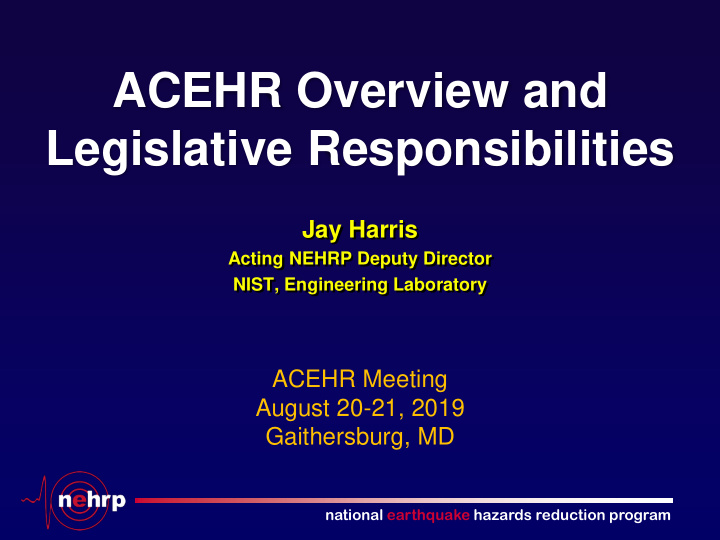



ACEHR Overview and Legislative Responsibilities Jay Harris Acting NEHRP Deputy Director NIST, Engineering Laboratory ACEHR Meeting August 20-21, 2019 Gaithersburg, MD national earthquake hazards reduction program
ACEHR Overview • Advisory Committee on Earthquake Hazards Reduction • Established in NEHRP Reauthorization Act of 2004 • no modification from 2018 reauthorization • At least 11 members who are qualified to provide advice on earthquake hazards reduction and represent all related scientific, architectural, and engineering disciplines • Recommendations of the Committee shall be considered by Federal agencies in implementing the Program national earthquake hazards reduction program
ACEHR Legislative Responsibilities • ACEHR shall assess— • trends and developments in the science and engineering of earthquake hazards reduction • the management, coordination, implementation, and activities of the Program • effectiveness of the Program in carrying out Program Activities • the need to revise the Program national earthquake hazards reduction program
Program Activities • Program Activities are designed to— • develop effective measures for earthquake hazards reduction • promote the adoption of earthquake hazards reduction measures by Federal, State, and local governments, national standards and model code organizations, architects and engineers, building owners, and others with a role in planning and constructing buildings, structures, and lifeline infrastructure through— • grants, contracts, cooperative agreements, and technical assistance; • development of standards, guidelines, and voluntary consensus codes for earthquake hazards reduction for buildings, structures, and lifeline infrastructure; • development and maintenance of a repository of information, including technical data, on seismic risk, community resilience, and hazards reduction; and • publishing a systematic set of maps of active faults and folds, liquefaction susceptibility, susceptibility for earthquake induced landslides, and other seismically induced hazards; and national earthquake hazards reduction program
Program Activities, cont. • Program Activities are designed to— • improve the understanding of earthquakes and their effects on communities, buildings, structures, and lifeline infrastructure, through interdisciplinary research that involves engineering, natural sciences, and social, economic, and decisions sciences • continue the development of the Advanced National Seismic System, including earthquake early warning capabilities and the Global Seismographic Network national earthquake hazards reduction program
ACEHR Membership • Current membership • Eleven appointed members • plus Greg Beroza, chair of the USGS Scientific Earthquake Studies Advisory Committee (SESAC) • Represented Disciplines • Engineering: 4 Structural, 1 Geotechnical • Seismology: 2 (1 is chair of SESAC) • Social Science: 3 • Emergency Management: 1 • Policy: 1 • Recent membership changes • End of term • David Simpson’s first term ended in May • Jim Goltz’s and Peter May’s second term ended in July national earthquake hazards reduction program
ACEHR Membership • Recent membership changes • Appointed members • Keith Koper, Professor in the Department of Geology and Geophysics and Director of Seismograph Stations, University if Utah • Lucy Arendt, Professor of Management, St. Norbert College • Susan Dowty, Regional Manager of Government Relations, International Code Council • The NEHRP Office is working on • Filling two positions with a geotechnical engineer and an emergency manager (for Davis and Goltz) • Reviewing possible candidates (for May and Gould) national earthquake hazards reduction program
Recommend
More recommend